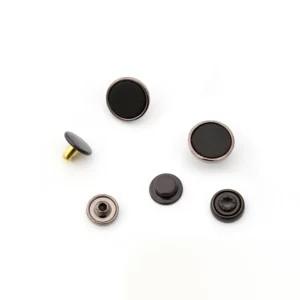How do you care for press button clothes during laundering?
Caring for press button clothes during laundering is relatively straightforward. Here are some general guidelines:
Pre-Treatment: Before washing, it’s a good idea to check the garment for any stains or spots and treat them accordingly. Follow the care instructions provided by the clothing manufacturer to ensure you use the appropriate stain remover or pre-treatment method.
Fasten the Buttons: Before tossing the garment into the washing machine, make sure to fasten all the press buttons. This helps prevent the buttons from snagging or causing damage to other garments or the washing machine drum.
Select the Proper Washing Cycle: Refer to the care label on the garment to determine the recommended washing instructions. Follow the guidelines for water temperature, cycle type (e.g., delicate, normal), and any specific instructions provided.
Use Gentle Detergent: Opt for a mild, gentle detergent suitable for the fabric type of the garment. Harsh chemicals or bleach can potentially damage the buttons or the fabric surrounding them.
Wash with Similar Colors: To avoid color bleeding or transfer, it’s advisable to wash press button clothes with similar colors or follow the garment’s care label instructions regarding color separation.
Avoid Aggressive Washing: Choose a gentle or delicate cycle to minimize agitation and reduce the risk of buttons getting pulled or damaged. Aggressive washing can potentially loosen or detach the buttons from the fabric.
Use a Mesh Bag (Optional): If you’re concerned about the buttons or the garment’s delicate areas, consider placing it in a mesh laundry bag for added protection during the washing process.
Air Dry or Follow Care Label Instructions: After washing, check the care label for drying instructions. In many cases, it is recommended to air dry press button clothes by laying them flat or hanging them up. Avoid using a dryer unless explicitly instructed on the care label.
Button Inspection: Once the garment is dry, inspect the press buttons for any damage or loose attachments. If you notice any issues, repair or replace the buttons as needed.
It’s important to note that these care instructions are general guidelines, and it’s always best to follow the specific care recommendations provided by the clothing manufacturer to ensure the longevity and appearance of your press button clothes.
What types of garments commonly feature press buttons?
Press buttons, also known as snap buttons or snap fasteners, are commonly used in various types of garments for fastening purposes. Some of the garments that often feature press buttons include:
Shirts and Blouses: Press buttons can be found on the front placket of shirts and blouses, allowing for easy closure and opening.
Jackets and Coats: Many jackets and coats incorporate press buttons as a convenient and secure way to fasten the front opening.
Pants and Shorts: Press buttons are sometimes used as closures for waistbands or fly openings in pants and shorts, press button clothes providing a quick and efficient way to fasten and unfasten.
Dresses: Press buttons can be used on the back or side closures of dresses, ensuring a streamlined and easy-to-use fastening method.
Skirts: Skirts may feature press buttons on the waistband or side closures for a secure and adjustable fit.
Baby and Children’s Clothing: Press buttons are often used in baby onesies, rompers, and children’s clothing for quick diaper changes and easy dressing.
Bodysuits and Leotards: Garments like bodysuits and leotards frequently utilize press buttons at the crotch area for convenience during wearing and changing.
Accessories: Press buttons can also be found in various accessories such as bags, wallets, and hats, providing functional closures.
It’s worth noting that the use of press buttons can vary depending on the design and style of the garment. They offer a versatile and efficient alternative to other fastening methods like zippers, buttons, or hooks, allowing for easy opening and closing of clothing items.
